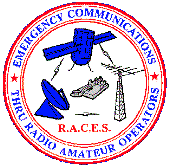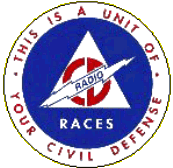 Radio Radio
Amateur
Civil
Emergency
Service |
 |
Joint sponored and administered by the FEDERAL EMERGENCY MANAGEMENT
AGENCY and the FEDERAL COMMUNICATIONS COMMISSION.
Communication: The Key To Survival.
Reliable communication is essential to emergency response. RACES can make
the difference between life and death. It can be a vital link in this life-saving
emergency communication network.
What is RACES?
Radio Amateur Civil Emergency Service (RACES) provides for amateur radio
operation for emergency communications purposes only, during periods of
local, regional, or national emergencies.
RACES is an essential link to help warn people about disasters. 
RACES networks
Every RACES station is a part of one or more emergency
communications networks. These networks provide vital communication for:
-
Local government emergency operating centers
-
State government emergency operating centers
-
Remote locations
"All communications in the Radio Amateur Civil Emergency
Service must be specifically authorized by the civil defense organization
for the area served."
Federal Communications Commission
-
RACES plans no longer require FCC approval.
-
FCC no longer assigns club call signs.
RACES operators are indispensable for emergency
communications. Amateur radio operators (FCC-licensed) can help save lives.
When is RACES needed?
The RACES organization of amateur radio operators is vital during such
emergencies as:
-
National Disasters
-
Tornadoes
-
Hurricanes
-
Earthquakes
-
Nuclear Accidents
-
Floods
-
Blackouts
-
Bomb Threats
Frequently, normal communication systems sustain damage during these types
of emergencies. It is then that RACES operators are invaluable to emergency
managers.
During national emergencies, RACES operators are the only amateur
radio operators permitted on the air. In an emergency, RACES operators
are assigned specific frequencies within authorized frequency bands as
directed by emergency management officials.
FEMA's State and Local Direction and Control Program provides support
to state and local governments and Emergency Broadcast System stations
through the following elements:
-
Emergency Operating Centers (EOC) Program
-
Warning and Communications Systems (WCS) program
-
Maintenance and Services (MS) program
-
Broadcast Station Protection Program (BSPP)
-
Emergency Broadcast System (EBS) Operational Area Planning, and
-
Electromagnetic Pulse (EMP) Technical Support program
RACES in Mississippi
For more information on RACES in your county, contact:
(Under Construction)
NOTE: This page is an HTML formatted copy of the Federal Emergency
Management Agency's pamphlet L-136/July 1983, and is provided "as is" for
informational purposes only. No claim is made as to the accuracy or validity
of any of the information within.
Home
 Radio
Radio

 Radio
Radio

